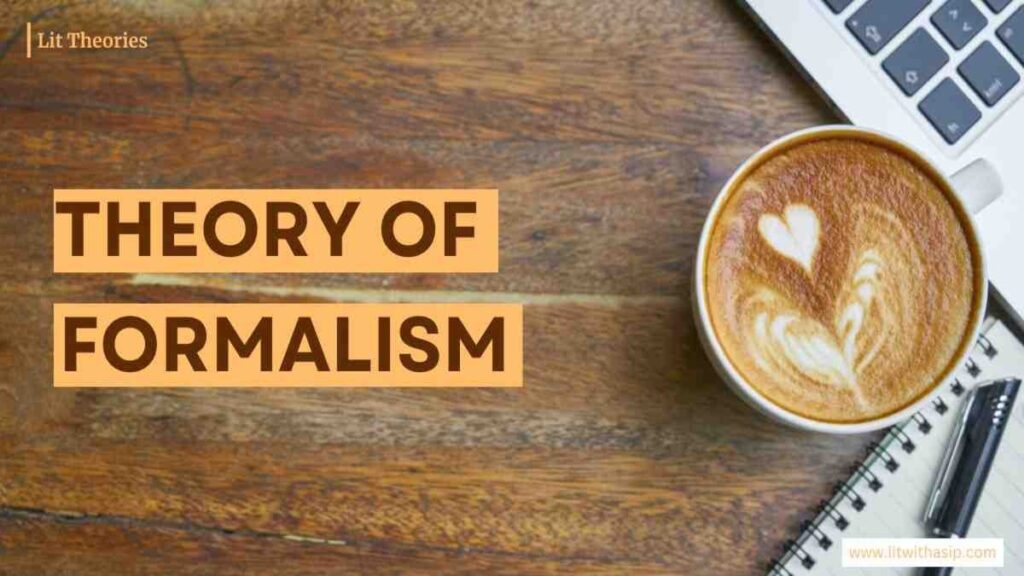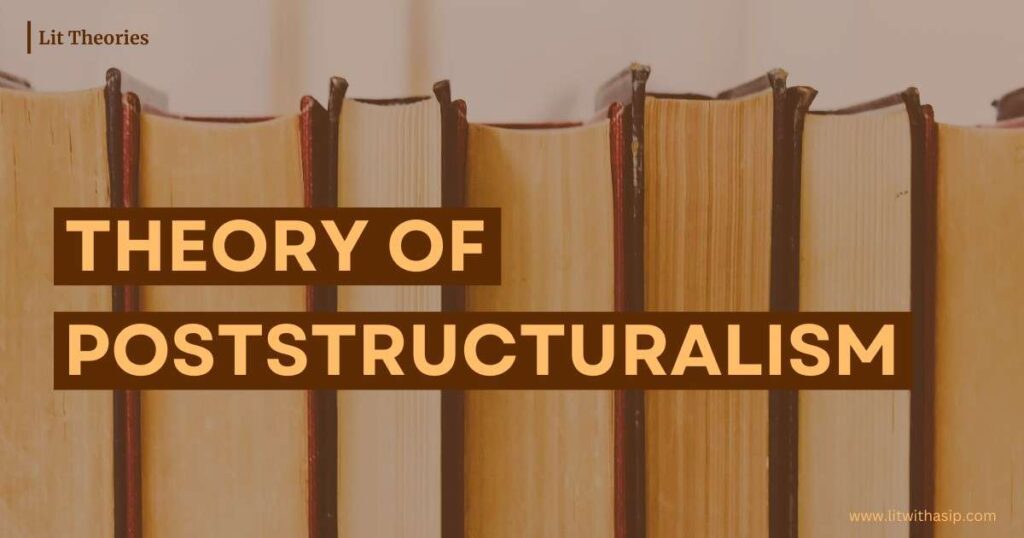One of the foundational theories in literature, Structuralism was theorized in the early 20th century by Ferdinand de Saussure (1857-1913), a Swiss philosopher and linguist. This theory talks about the ‘structure’ of language and provides a framework for understanding the shape of human experiences, society, and communication.
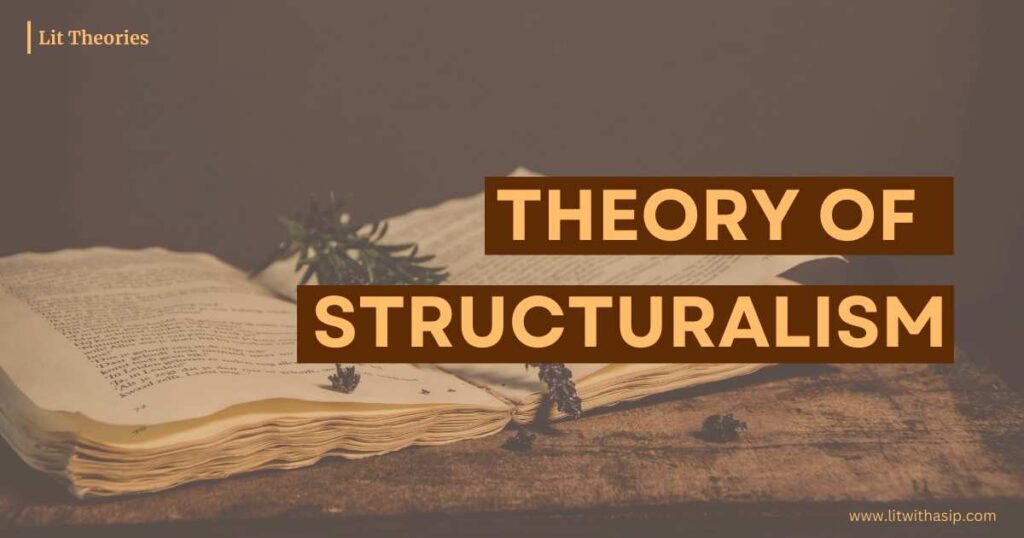
The theory also reflects how words and their grammatical meanings have evolved through generations. It also states how language is an interplay of signs and their significations, the elements of which only make sense when correlated with some other element or the whole system, unlike being interpreted individually.
We will understand these concepts in detail along with their applications and relevance in today’s time below. So, make sure that you read till the end…
Background
Structuralism originated in the early 20th century with the works of Ferdinand de Saussure, who introduced his concepts in “Course in General Linguistics” (1916). A fact worth noting is that Saussure did not directly author this work. He only delivered lectures at the University of Geneva and his students, like Charles Bally and Albert Sechehaye, compiled and published his key ideas posthumously. This compilation became foundational for modern linguistics.
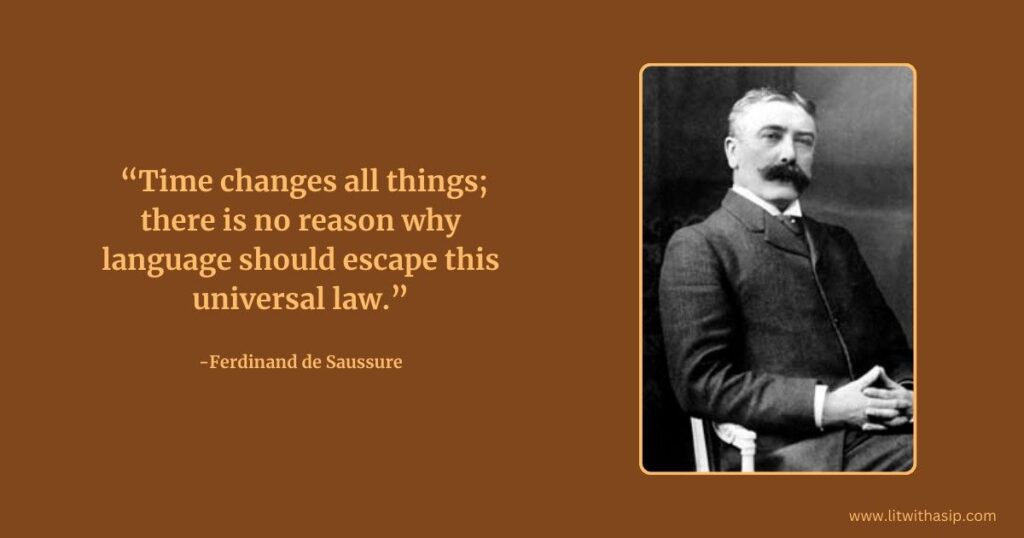
The theory emerged primarily from linguistics and later influenced various disciplines such as anthropology, literary theory, and sociology. It rose to popularity in the 1950s and 1960s, with France majorly accounting for the application of structuralist ideas. Scholars like Claude Lévi-Strauss applied structuralist principles to anthropology, Roland Barthes to literary theory and semiotics, and Jacques Lacan to psychoanalysis.
Core Concepts
The key concepts that the theory of Structuralismfocuses upon are as follows:
Sign, Signifier, and Signified
The theory posits that language is a system of signs where each signcomprises a signifierand a signified. Sign is the basic unit of meaning in language. Signifier is the form of the word or expression, the sound, or the image. Signified is the concept or meaning the signifier refers to, which could vary from person to person. Let us comprehend this concept better with the help of an example. You may refer to the image below:
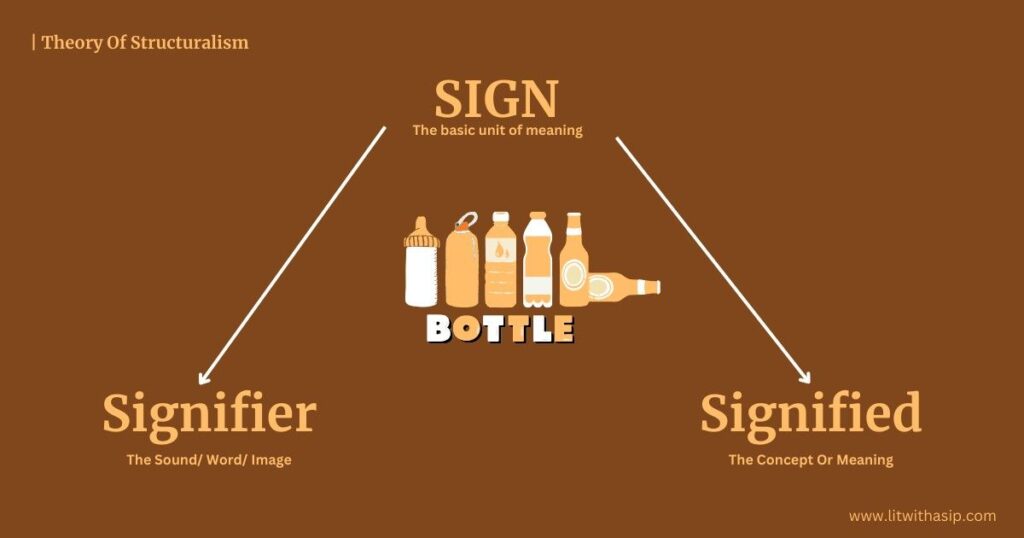
Let’s take ‘bottle’ as an example. The signifier is the word ‘bottle’ itself, which is the spoken or written form that we use to refer to the object. The signified is the concept or mental image of a bottle, which includes its function as a container for liquids.
The relationship between the signifier ‘bottle’ and the signified concept is arbitrary and established by cultural convention. Some might understand it as a bottle made of glass, plastic, copper, or more. Some might understand it as a bottle of water, drinks, or even medicine. Without this shared understanding within a language community, the word ‘bottle’ would have no inherent meaning.
Therefore, signs only gain meaning within the context of a language system, not in isolation. This concept emphasizes that meaning arises from differences and relationships between signs rather than from any inherent connection between a word and its referent. This makes language not only clearer to understand but also unique in the way it is communicated.
Binary Oppositions
Another key principle is the idea of binary oppositions, which are pairs of contrasting concepts that structure human thought and culture. For example, good and evil, light and dark, or black and white.
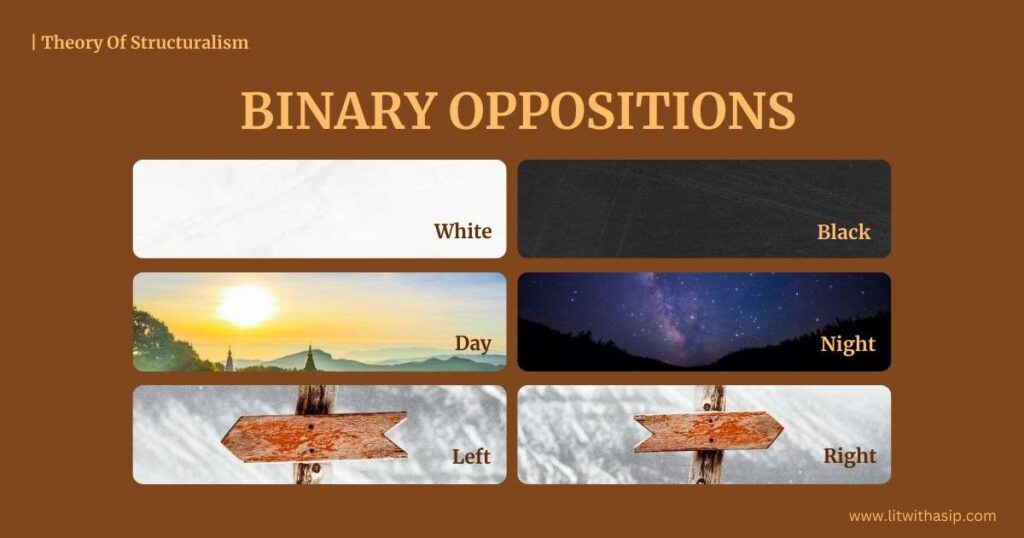
Structuralists argue that meaning is generated through these oppositions, as each term is defined in relation to its opposite. We do not only understand a term as an individual entity through the meaning attached to it, but we also understand it by drawing comparisons to the meaning of its opposite.
This creates a structure of language for understanding and interpreting the world, as these binary oppositions form the foundational framework through which we categorize and make sense of our experiences. This framework also helps to reveal the underlying structures that govern various cultural and social phenomena, highlighting how opposites are interdependent and shape our understanding of the world.
Langue and Parole
Saussure distinguished between langue(the abstract, systematic rules and conventions of a language) and parole(the individual, actual use of language in speech and writing). Langue represents the underlying structure that makes communication possible, while parole refers to specific, concrete instances of language use. Shortly, Langue is the ‘system’ of language and Parole is that system ‘put into usage’. Let’s make the understanding easier through an example.
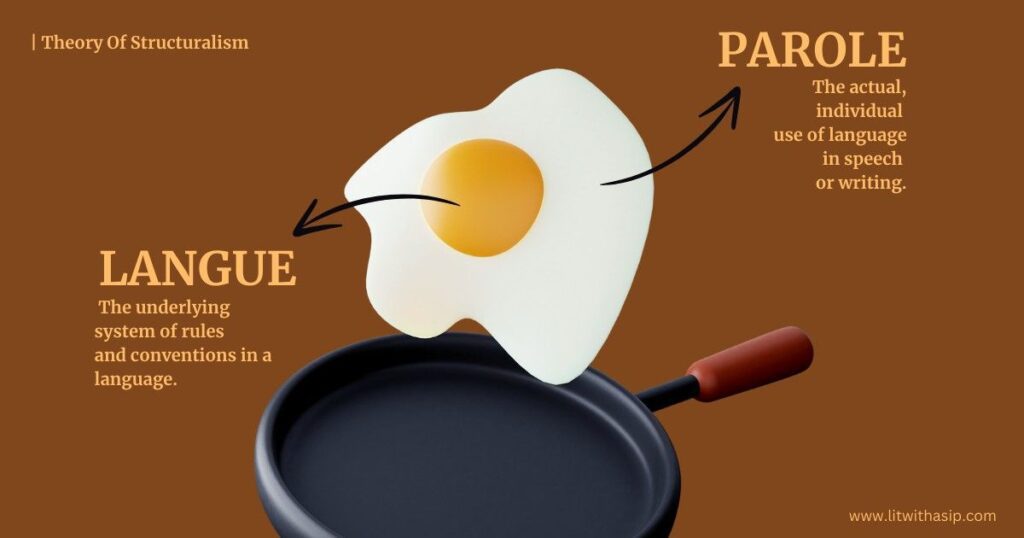
Langue and parole can be exemplified through the use of a greeting in English. Langue represents the abstract, systematic rules and conventions of the English language, such as grammar, syntax, and vocabulary, which include the accepted ways of forming greetings like “Hello,” “Hi,” or “Good morning.” Parole, on the other hand, refers to the actual, specific instances of language use. For example, when a person says “Hey Mate!” to a friend on the street. Now, this way of greeting can be called parole.
The Structuralist theory focuses on langue to uncover the rules and patterns that govern how language operates as a system, suggesting that understanding these structures can reveal deeper insights into cultural and social practices. Parole, however, doesn’t conform to these systematic rules and patterns rigidly; it reflects individual variations and contextual nuances in speech and writing. While langue represents the idealized, consistent structure of language, parole captures the diverse and sometimes unpredictable ways people actually use language in everyday life.
Synchronic and Diachronic Analysis
Synchronic and Diachronic analysis are two complementary approaches in the study of language and cultural systems, each offering unique insights that together provide a more comprehensive understanding. The two might seem to be contrasting, but they majorly complement each other in most places. Below is a more vivid explanation of both terms along with their easy-to-understand examples…
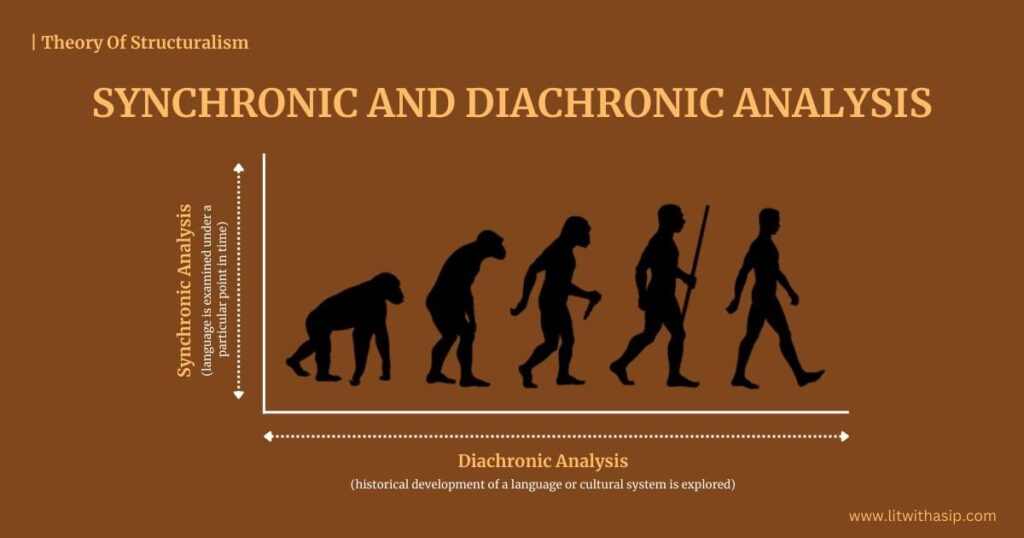
As per the Synchronic Analysis, language is examined at a particular point in time. For instance, when looking at how English is today, we draw analysis through the contemporary meaning and approach. You may consider the contemporary usage of the word “tweet” which commonly refers to a post made on the social media platform Twitter (now called ‘X’). This analysis would not consider the historical evolution of the word “tweet” but rather analyze how “tweet” is understood and used in this current context, including its connotations, frequency of use, and its role in digital communication.
Concurrently, Diachronic Analysisstudies the evolution and historical development of a language or cultural system. In this kind of analysis, one may trace a word’s connotation from Old English to its present form. For instance, the word “gay” primarily meant “happy” or “carefree” until the mid-20th century. Specifically, this usage was prevalent from the late 19th century and earlier. By the mid-20th century, “gay” began to be more commonly used to refer to homosexuality. The shift in meaning became more pronounced in the 1960s and 1970s.
Structures and Systems
The Structuralist Theory emphasizes the importance of underlying structures in shaping cultural and social phenomena. These structuresare seen as systems of relationships and differences that produce meaning. As a result, these systemsbecome the broader, interconnected networks within which structures operate that consist of various elements that interact according to specific rules and relationships. Let us understand this through literary examples…
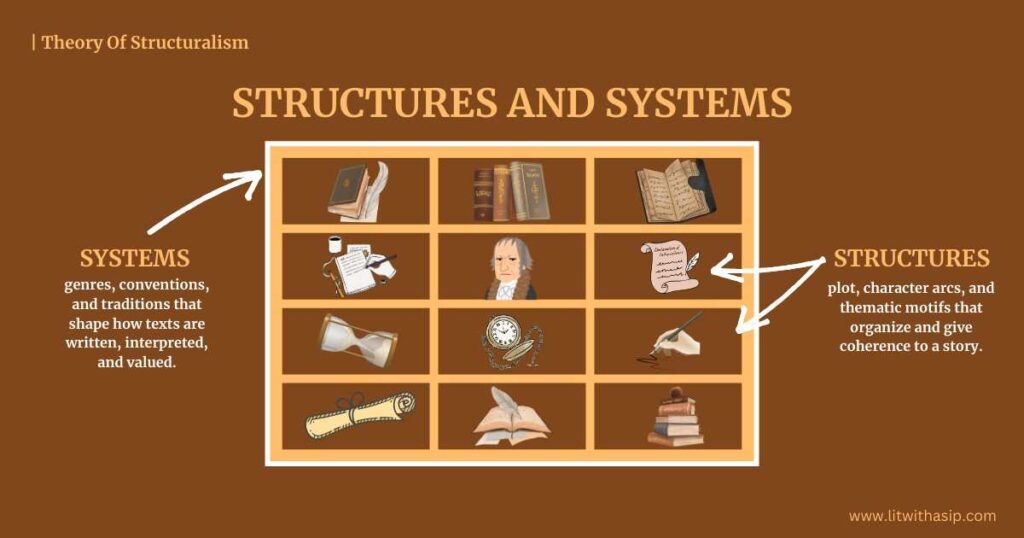
The plot, character arcs, and thematic motifs that organize and give coherence to a story are examples of the structuresof language. Whereas, genres, conventions, and traditions that shape how texts are written, interpreted, and valued, serve as examples of the systemsof a literary work.
For instance, in Charles Dickens’s Great Expectations, the narrative structure follows the bildungsroman genre, which shapes the protagonist’s development and moral growth. The character transformations of Pip, Estella, and Miss Havisham, along with recurring themes of social class and personal redemption, form the structural elements of the novel. Meanwhile, the broader literary system includes Victorian conventions and social commentary that influence the way the novel is written and understood, reflecting the cultural and historical context of the 19th century. This system provides the framework within which the structural elements operate, allowing for a deeper understanding of the novel’s meaning and significance.
Let us now understand the applications of this theory as are in Literature today…
Applications in Literature Today
Structuralism continues to be a valuable analytical tool in contemporary literary studies. Here are some key applications:
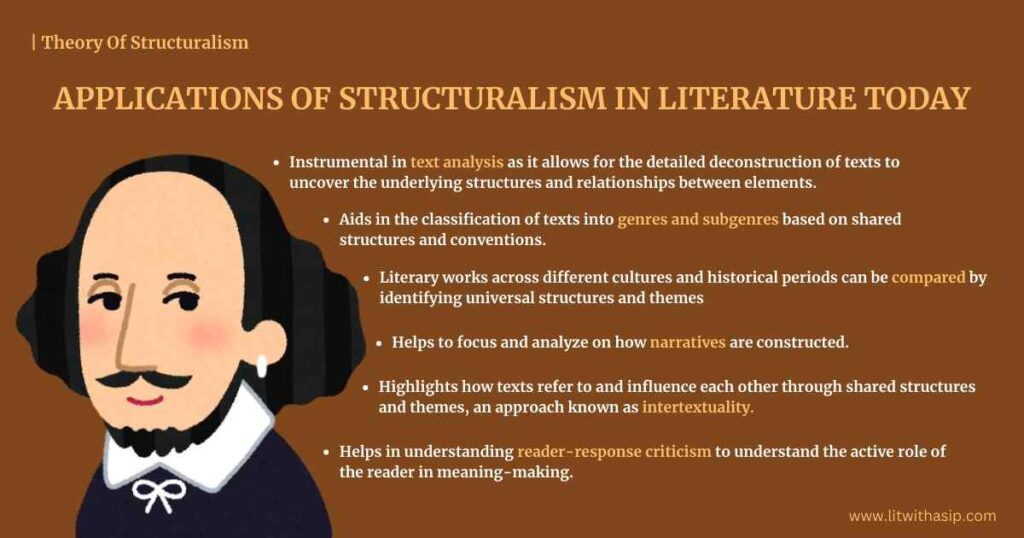
- The theory of Structuralismis instrumental in text analysis as it allows for the detailed deconstruction of texts to uncover the underlying structures and relationships between elements. By analyzing the interplay of signs, signifiers, and signifieds, scholars can reveal deeper layers of meaning and understand how narratives create and convey meaning. The theory enables structuralists to examine recurring motifs and symbols in a text to form an understanding of the themes at a broader level.
- It aids in the classification of texts into genres and subgenres based on shared structures and conventions. We understand how genres help define readers’ expectations and interpretations. Probably, how and why one says ‘That’s not my genre’ or ‘that’s my type’.
- It provides tools for practicing comparative literaturewhere literary works across different cultures and historical periods can be compared by identifying universal structures and themes. This highlights the similarities and differences in how various cultures construct narratives and meanings.
- Structuralist analysis focuses on how narrativesare constructed, including the roles of plot, character arcs, and thematic motifs. This helps in dissecting how stories function and how they impact the audience.
- The theory highlights how texts refer to and influence each other through shared structures and themes, an approach known as intertextuality. This helps in tracing literary influences and understanding the dialogues between different works.
- While this theory traditionally focuses on texts, it also provides insights into how readers interpret and interact with texts. This intersects with reader-response criticism to understand the active role of the reader in meaning-making.
Notably, the Structuralist Theory also finds application in various other fields of study. Let us have a look at them one by one…
Applications in Other Disciplines
Not only Literature, the Structuralist Theory finds applications in various other disciplines, such as:
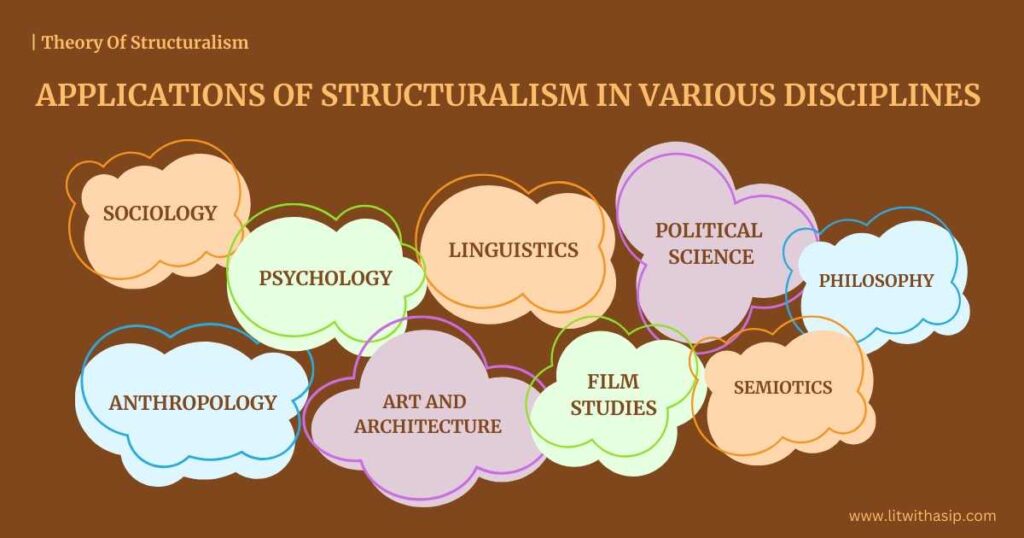
- In Anthropology, the structuralist approach is used to analyze myths, kinship structures, and social rituals, especially through the work of Claude Lévi-Strauss. It seeks to uncover the universal structures that underlie human culture and thought. Lévi-Strauss analyzed how myths across different cultures help identify common patterns and binary oppositions, such as life vs. death and nature vs. culture.
- In Sociology, the theory examines the underlying social structures that shape human behavior and institutions. This includes analyzing social norms, roles, and hierarchies. One can understand how class distinctions are maintained through language, education, and economic systems, as an example.
- The use of this theory in Psychology, pioneered by Wilhelm Wundt and Edward Titchener, focuses on breaking down mental processes into their basic components. For instance, introspection can be used to analyze the basic structures of conscious experience, such as sensations, feelings, and images.
- Linguistics also grew towards analyzing the rules of syntax to understand how sentences are constructed in different languages, and how meaning is generated through linguistic signs. This is due to Saussure’s application of the theory in this discipline to focus on the structures of language, such as syntax (sentence structure) and semantics (meaning).
- It is applied to analyze Film Studies, such as the underlying structures of film narratives, including plot, genre conventions, and cinematic techniques. Analyzing how classic Hollywood films follow the three-act structure and employ visual motifs to convey themes is just an example of the same.
- In Political Science, it examines the structures of political ideologies and institutions, revealing the underlying rules and patterns that govern political behavior and thought. For instance, the structure of democratic institutions to understand how power is distributed and maintained.
- In Philosophy, it helps explore the structures of knowledge and how human understanding is shaped by underlying frameworks. One can get this through the way different philosophical systems structure knowledge and reality.
- Structuralist ideas are fundamental in Semiotics, the study of signs and symbols, examining how meaning is constructed through sign systems. Advertisements come as a great example, helping understand how visual and textual signs create meaning and influence consumer behavior.
- In Art and Architecture, it focuses on the underlying structures that inform design principles and aesthetic values.
Structuralism Criticized
While Structuralismhas significantly influenced the study of language, culture, and society, it has also faced substantial criticism and debates. It is often criticized for focusing too much on the underlying structures at the expense of individual differences and agency. It is also accused of ignoring historical and temporal changes, as it tends to analyze cultural phenomena as if they exist in a vacuum. Sometimes viewed as being too narrow, the theory is primarily useful for analyzing texts and language but less applicable to other fields or more complex social phenomena. Arguments claiming structures to not be as stable or universal as structuralists claim, the theory of Post-Structuralism was given way.
Modern Relevance
The modern relevance of structuralist ideas lies in their enduring influence on various fields, providing foundational insights into the systematic and relational nature of language, culture, and society. Even as post-structuralist and other contemporary theories have emerged, Structuralism’s focus on uncovering the underlying structures and patterns that shape meaning and human behavior remains a valuable analytical tool.
Its principles continue to inform critical methodologies across various disciplines, enabling scholars to dissect complex cultural texts and social phenomena with a focus on relational dynamics and systemic organization. In today’s interconnected and rapidly evolving world, the theory’s emphasis on understanding the deeper frameworks that govern cultural and social practices retains significant intellectual and practical relevance.

Jennis Jacob, a passionate literary enthusiast in her 20s, is a writer and poet. With eight years of experience in literature, she is currently a master in English and finds inspiration in Womanist, American, and Indian Partition Literatures. Her works have appeared in anthologies such as ‘Carved Words Of Creative Minds’ and ‘100 Splendid Voices,’ and she is working on upcoming books. Through LitWithASip, she aims to ignite a love for literature and empower individuals to embrace their true selves.
